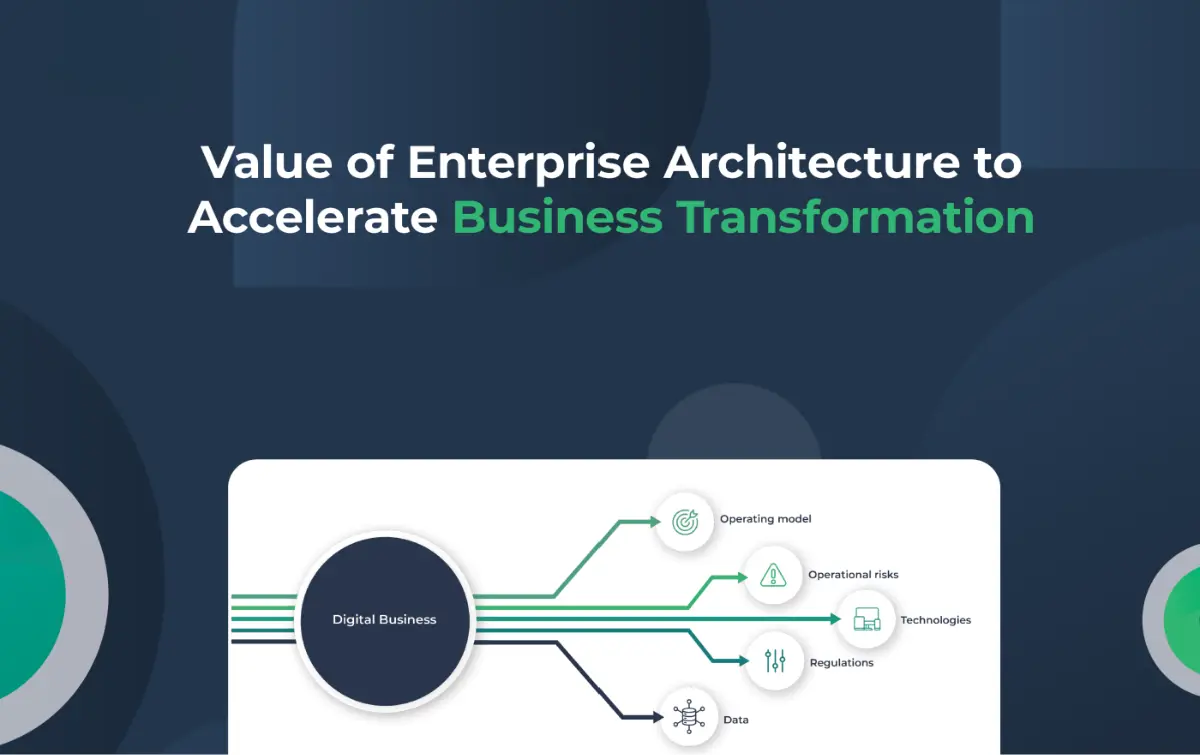
Business Architecture: Principles, Frameworks, and Best Practices
Business architecture is an essential element of corporate strategy. As businesses continue to evolve, the need for structure and organization increases. This is where business architecture comes in.

Business architecture provides a clear roadmap for businesses and helps align business functions with the overall strategy. By establishing a clear blueprint of the organization's operating model, the business architecture enables businesses to align their operations with their overall strategy.
It also assists businesses in identifying the dependencies and interrelationships of their various business units, facilitating efficient workflows and reducing operational inefficiencies. In this article, we'll look closer at the definition of business architecture and its crucial role in achieving business success.
What is Business Architecture?
Business architecture is analyzing and designing business processes, functions, and structures. This includes identifying areas for improvement, defining rules and guidelines, and aligning tasks with the overall strategy. Essentially, it's a blueprint for how a business operates.
How is business architecture different from enterprise architecture?
While business architecture sometimes focuses on specific business functions and how they can be improved, enterprise architecture takes a broader approach by looking at the entire organization and how different functions interact. Enterprise architecture also often includes technology architecture, while business architecture is strictly focused on business.
Why is business architecture important?
Business architecture is important because it provides structure and organization to businesses. It helps companies to identify areas for improvement and provides a roadmap for how to get there. Additionally, with a clear understanding of business architecture, businesses can align functions with overall strategy, leading to increased efficiency and profitability.
Key Components of Business Architecture

Business Models
Business models outline how an organization creates, delivers, and captures value. They define the revenue streams, target customer segments, key activities, resources, and partnerships required to sustain the business. A well-defined business model helps organizations identify opportunities, adapt to market changes, and drive innovation.
Capabilities
Capabilities refer to an organization's ability to perform specific tasks or activities. They include the skills, knowledge, processes, and resources needed to deliver products or services. Understanding and defining capabilities is essential for identifying gaps, optimizing operations, and aligning resources with strategic objectives.
Processes
Processes represent the sequence of activities or tasks performed to achieve specific outcomes. They define how work is done within an organization, including the flow of information, decision-making, and collaboration. Business architecture helps organizations streamline processes, eliminate bottlenecks, and improve efficiency and effectiveness.
Information
Information is a critical asset for any organization. Business architecture identifies the types of information required and how it is captured, stored, processed, and shared across the organization. By ensuring the availability, integrity, and accessibility of information, the business architecture supports data-driven decision-making and fosters a culture of information management.
How can business architecture be used?
Business architecture is valuable because it explains how a business operates and how different functions interact. By understanding these interactions, companies can identify areas for improvement and make more informed decisions.
How to engage in business architecture
Engaging in business architecture involves identifying critical business capabilities, processes, and functions, analyzing them, and developing an improvement plan. A business architect is responsible for analyzing and designing business capabilities and processes and ensuring they align with the overall strategy.
Get a complimentary copy: 2024 Gartner® Magic Quadrant™ for Enterprise Architecture Tools
Overview of the architecture framework
The architecture framework is the methodology used for developing a business architecture. It includes defining business capabilities, identifying business processes, and aligning functions with overall strategy. The framework provides a clear roadmap for developing and implementing a business architecture.
What is the Business Architecture Guild?
The Business Architecture Guild is an organization that promotes the practice of business architecture. It provides resources, training, and support to help business architects develop effective business architectures.
Benefits of Membership
Membership in the Business Architecture Guild provides access to a community of business architects, resources, and training to help develop and implement effective business architectures.
How to get involved
To get involved with the Business Architecture Guild, visit their website, Business Architecture Guild, to learn more about membership and available resources.
How does business architecture serve business units?
Effective business architecture can help businesses identify areas for process improvement. By understanding how different business functions interact with each other, businesses can make more informed decisions about optimizing those processes.
Aligning business architecture with business strategy
Business architecture helps businesses align functions with the overall strategy. Businesses can increase efficiency and profitability by ensuring that all functions work together towards the same goal.
Elements of business architecture for successful implementation
Successful implementation of business architecture requires identifying key business processes, creating a roadmap for improvement, and ensuring that all functions are aligned with the overall strategy. It also requires the involvement of a business architect, who can help analyze and design business processes.
What are some popular enterprise architecture frameworks?
Technology architecture is a component of enterprise architecture that focuses on the technology used by a business. This includes hardware, software, and networking.
Process architecture in enterprise architecture frameworks
Process architecture is another component of enterprise architecture that focuses on a business's business processes. This includes identifying key processes, defining rules and guidelines, and ensuring all processes align with the strategy.
Building effective enterprise architecture with business architecture
Using business architecture as a foundation, businesses can develop effective enterprise architecture frameworks by identifying key business processes and how they interact. This can help enterprises to optimize their processes and improve overall efficiency.
Summary
Business architecture is a crucial discipline that enables organizations to understand, optimize, and transform their operations. By providing a holistic view of the organization's structure, processes, capabilities, information, and technology, business architecture empowers stakeholders to make informed decisions, drive innovation, and achieve long-term success.
FAQs
Business Architecture applies a holistic approach to designing and optimizing business operations and processes. It is a comprehensive framework that aligns an organization's business goals with its strategies, processes, systems, technology, information, and people.
A Business Architect is a professional specializing in designing and implementing business architecture. They liaise between business leaders and IT experts and are responsible for developing and maintaining business architecture frameworks.
Business Architecture is valuable because it explains an organization's business processes, goals, and strategies. With a well-defined business architecture, organizations can identify inefficiencies, gaps, and opportunities for improvement. This, in turn, enables them to streamline their operations, reduce costs, increase profits, and stay competitive.
The five elements of business architecture are the key components that define an organization's strategies, business capabilities, processes, information, and stakeholders. First, the business strategy is the foundation for creating a roadmap for achieving business objectives and goals. Then, the business capabilities are the abilities and competencies required to achieve the organization's strategy. Next, the business process consists of activities transforming inputs into outputs to deliver customer value. The fourth element is information, the data needed to operate and support business processes. It includes structured and unstructured information, such as transactional data, customer feedback, and other forms of data.
It is time to engage in Business Architecture when an organization faces challenges such as low productivity, high costs, poor customer satisfaction, or lack of agility. It is also crucial when an organization undergoes a major change, such as a merger, acquisition, or restructuring.
An organization can engage in Business Architecture by establishing a Business Architecture practice, hiring a Business Architect, or working with a consulting firm specializing in Business Architecture.
The elements of Business Architecture include strategy, capabilities, business processes, organizational structure, systems, technology, data, and human resources. These elements are interdependent and form a comprehensive framework that aligns an organization's business goals with its operations.
An organization can ensure an effective Business Architecture implementation by involving all stakeholders, including business leaders, IT experts, and end-users. It is essential to establish clear goals, metrics, and performance indicators and communicate the value of Business Architecture to all stakeholders.
No, business architecture is relevant for organizations of all sizes. It helps small and medium-sized businesses streamline their operations, align their strategies, and optimize their resources for growth and competitiveness.
Reduce IT complexity and costs while supporting business innovation

Support fast-changing business needs and innovation with a well-designed application portfolio management solution.
Enterprise Architecture Related Content
Shift from a documentation tool to an operational tool and accelerate business transformation
MEGA HOPEX for Enterprise Architecture
Request a demonstration of HOPEX for EA, and see how you can have immediate value of your projects.











